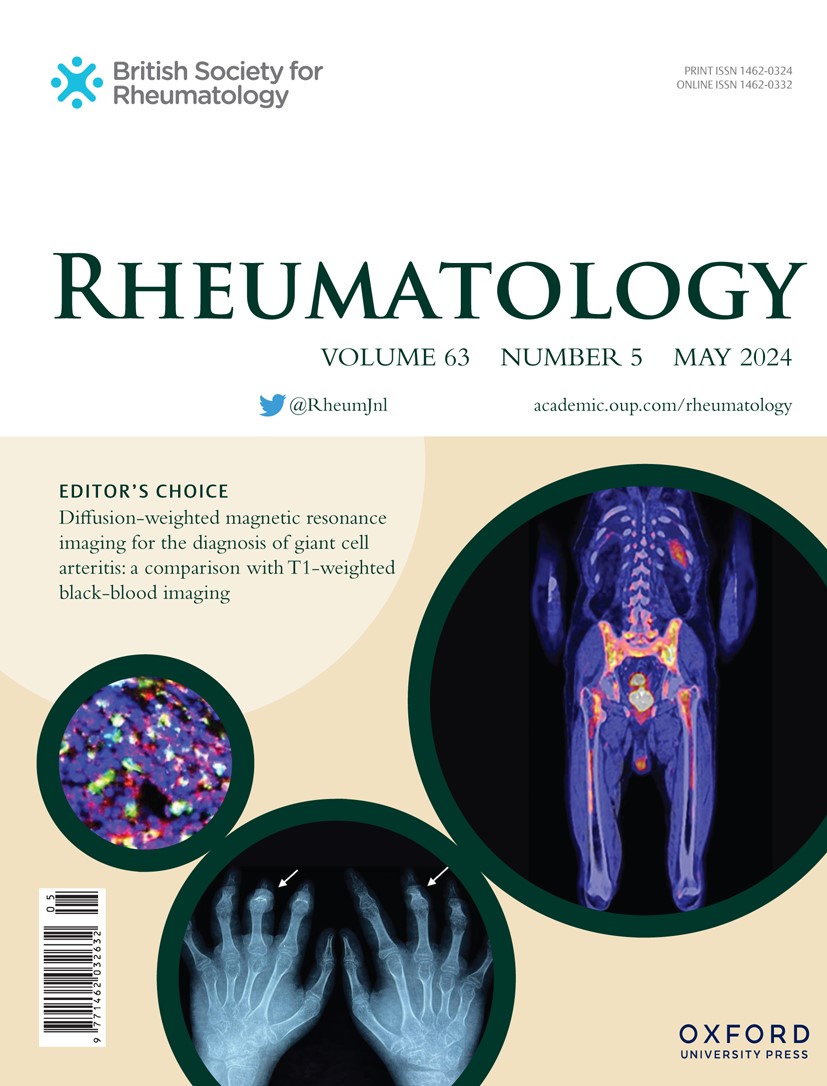疾病改变青少年特发性关节炎的抗风湿药物治疗周期和发作率——西西弗斯努力的故事?
IF 4.7
2区 医学
Q1 RHEUMATOLOGY
引用次数: 0
摘要
目的:在JIA治疗中,停用疾病调节抗风湿药物(DMARDs)以确定是否需要持续用药是很常见的。很少有人知道病人接受停药试验的频率或连续试验的结果。本研究在JIA队列中检查了DMARD治疗周期,以确定在随访期间发生停药试验的频率以及复发率在连续周期中是否发生变化。方法回顾性分析2010 - 2014年经dmard治疗的JIA患儿的纵向队列资料。提取的数据包括人口统计学、DMARD治疗细节和临床评估,包括活动关节计数、最后一次随访日期和当时的疾病状况。数据收集至2024年1月。结果对91名儿童进行了调查。中位年龄10.1岁(1.5-16.8岁),59%为女性,中位随访年龄7.0岁(0.7-13岁)。最多进行4个周期的DMARD治疗。44.0%的儿童经历了一个以上的周期。第一次服药后复发的占63.5%,第二次服药后复发的占53.3%。在第一个治疗周期后,25.3%的患者到最后一次随访时仍未接受治疗,而在随后的两个治疗周期后,这一比例上升至35.2%。结论在需要DMARD治疗的JIA患者中,复发性停药试验在随访期间较为常见,但在后续试验中复发风险较高。因此,对于大多数目前可用的治疗方法的患者来说,永久停止治疗是不现实的目标。在开发出永久性缓解的生物标志物之前,需要制定策略,将停药后复发活动性疾病患者的药物毒性和疾病发作风险降至最低。本文章由计算机程序翻译,如有差异,请以英文原文为准。
Disease modifying anti-rheumatic drug treatment cycles and rates of flare in juvenile idiopathic arthritis—a tale of Sisyphean endeavour?
Objectives Withdrawal of Disease Modifying Antirheumatic Drugs (DMARDs) to determine need for ongoing medication is common in JIA management. Little is known about how often patients undergo trials of medication discontinuation or the outcomes of successive trials. This study examined DMARD treatment cycles in a JIA cohort to determine how frequently medication withdrawal trials occur over follow-up and if relapse rates change over consecutive cycles. Methods Retrospective review of longitudinal cohort data of children with DMARD-treated JIA diagnosed between 2010–14. Extracted data included demographics, DMARD therapy details and clinical assessments including active joint count, date of last follow-up and disease status at that time. Data was collected to January 2024. Results Ninety-one children were studied. Median age 10.1 yr (range 1.5–16.8), 59% were female and median follow-up 7.0 yr (range 0.7–13). A maximum of 4 cycles of DMARD treatment were undertaken. 44.0% of children underwent more than one cycle. 63.5% relapsed after their first cycle and 53.3% after their second. 25.3% remained off treatment to last follow-up following cycle one and over two subsequent cycles of therapy this increased to just 35.2%. Conclusion In JIA patients requiring DMARD therapy recurrent treatment withdrawal trials are common over follow-up, but relapse risk is high and remains so over successive trials. Permanent treatment withdrawal is therefore not a realistic goal for most patients with therapies currently available. Until biomarkers of permanent remission are developed, strategies to minimize both drug toxicity and the risk of disease flares in patients with recurrently active disease after medication withdrawal are required.
求助全文
通过发布文献求助,成功后即可免费获取论文全文。
去求助
来源期刊

Rheumatology
医学-风湿病学
CiteScore
9.40
自引率
7.30%
发文量
1091
审稿时长
2 months
期刊介绍:
Rheumatology strives to support research and discovery by publishing the highest quality original scientific papers with a focus on basic, clinical and translational research. The journal’s subject areas cover a wide range of paediatric and adult rheumatological conditions from an international perspective. It is an official journal of the British Society for Rheumatology, published by Oxford University Press.
Rheumatology publishes original articles, reviews, editorials, guidelines, concise reports, meta-analyses, original case reports, clinical vignettes, letters and matters arising from published material. The journal takes pride in serving the global rheumatology community, with a focus on high societal impact in the form of podcasts, videos and extended social media presence, and utilizing metrics such as Altmetric. Keep up to date by following the journal on Twitter @RheumJnl.
 求助内容:
求助内容: 应助结果提醒方式:
应助结果提醒方式:


